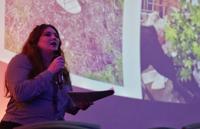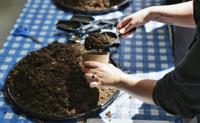
The UTA Planetarium and College of Science celebrated the one-year anniversary of their space-cultivated Moon Tree on Tuesday afternoon at the Planetarium, teaching attendees about the sapling’s off-Earth history.
The Planetarium received the sweetgum sapling from NASA and the United States Department of Agriculture Forest Service on April 24, 2024, and planted it outside the Chemistry and Physics Building the next day, according to previous Shorthorn reporting.
The sapling received its nickname Moon Tree after being one of several seedlings to orbit around the moon during Artemis I, an uncrewed lunar orbit mission.
Since its arrival at UTA, Planetarium coordinator McKenna Dowd said in an email the Moon Tree has grown to be 54 inches tall.
“I’m so thrilled that we’re a part of history in a sense,” Dowd said.
Dowd gave a presentation about Artemis I’s mission during the event. Five different tree species seedlings orbited the moon: Douglas Fir, Loblolly Pine, Giant Sequoia, American Sycamore and Sweetgum.

The seeds were sent into space for two reasons: to continue understanding how seeds can be taken into space and grow upon their return – a vital role for the future of human space exploration – and to give communities a living connection to space exploration, she said.
NASA’s Orion spacecraft carried the seeds, performing a half revolution of six days in an orbit 43,730 miles from the surface of the moon.
“It went farther than any human has ever travelled in space,” Dowd said.
Researchers measured the seedlings’ growth after their return to Earth, and their findings suggest that if the seeds are stored in sub-optimal conditions for a short period, they will continue to grow despite space travel, she said.
“This is huge for space exploration,” Dowd said in her presentation.
Artemis I saplings have taken root at 236 locations across the United States and organizations are cultivating more than just trees, she said. They are sparking curiosity about space, nurturing community connections and fostering a deeper understanding of NASA’s missions.

Once the show ended, guests enjoyed refreshments and participated in activities such as making a space souvenir and building a small, personal herb garden.
Ashley Garza, College of Science special events and alumni coordinator, said she wanted to help Dowd celebrate the Moon Tree through the “build a herb garden” activity, as it was a great way to connect outer space with environmental science.
“I think we’ve had a great turnout,” she said. “It’s simple, it’s also a study break for the students to do something.”
Nursing juniors Jackie Rodriguez and Carolina Trevizo participated in building their own herb garden. Trevizo said she chose cilantro because she uses the plant often, and Rodriguez said she chose borage because of the beautiful picture of the plant shown at the event.
“We were just walking in here and we saw everything set up and so we just came back when it started,” Trevizo said. “We were just interested by the plants and stuff.”
Looking forward to next year, Dowd said she hopes more UTA students will get involved with the Moon tree and NASA research, whether they are an art major, environmental science major or pursuing any other field of study.
“I’m super excited to just have a way for the community to learn about the Moon Tree and connect,” she said. “And hopefully get super excited and more involved with its presence on campus.”


















